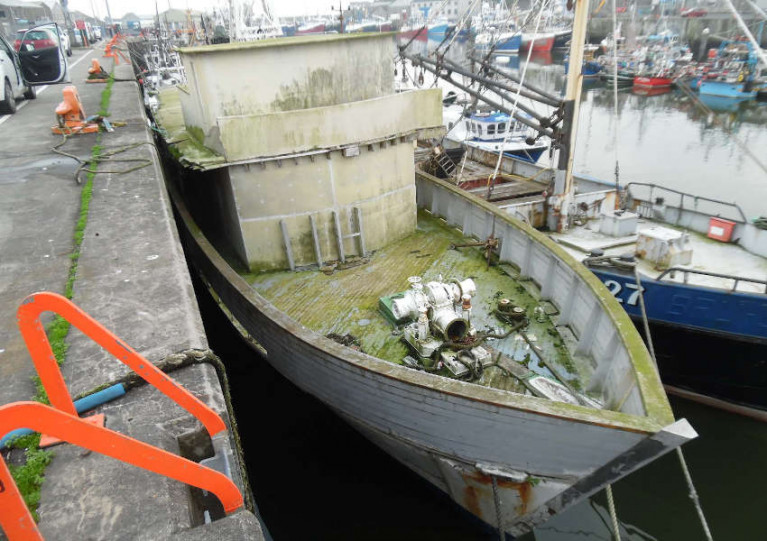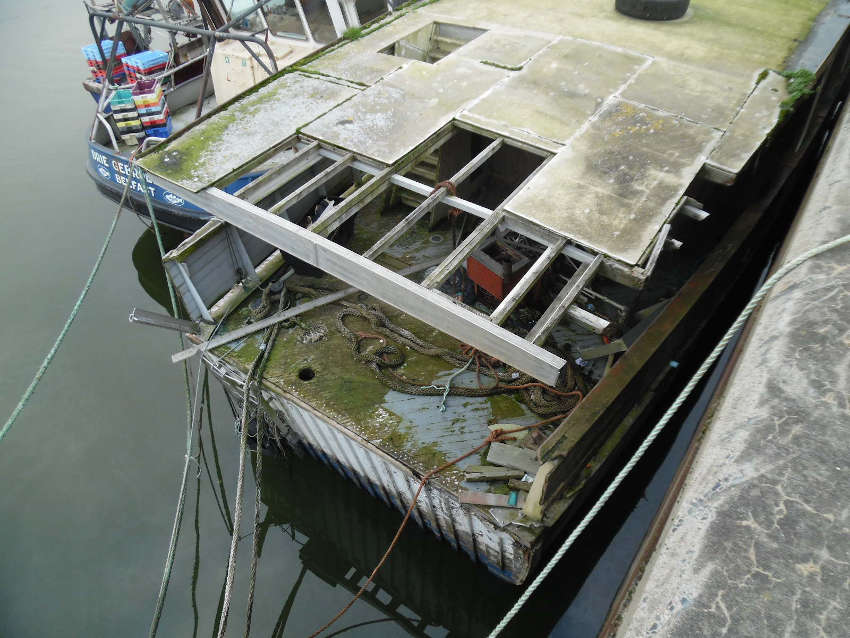Displaying items by tag: HMS Enterprise
The old minesweeper HMS Enterprise has all but submerged in Kilkeel Harbour in Northern Ireland, as Afloat.ie reader Lee Maginnis has shared with his.
His recent images of the vessel show a significant degradation from the last update in autumn 2022, when warning signage was affixed to the boat reading Abandoned Vessel - Danger Keep Out”.
As of Wednesday 22 March, the hull has almost entirely sunk beneath the water line in the Co Down harbour — an ignoble end for the former Royal Navy minesweeper which has a storied history.
“The photos say it all,” Maginnis tells Afloat.ie. “Don’t we look after our heritage well.”
 Another angle showing what’s left of the HMS Enterprise dockside at Kilkeel Harbour | Credit: Lee Maginnis
Another angle showing what’s left of the HMS Enterprise dockside at Kilkeel Harbour | Credit: Lee Maginnis
Signage Warns Public Away From ‘Abandoned’ Ex-Minesweeper HMS Enterprise in Kilkeel
Afloat.ie reader Lee Maginnis has provided an update on the current condition of the old minesweeper HMS Enterprise in Kilkeel Harbour, and the news is not good.
The former Royal Navy minesweeper with a storied history was previously anchored in Carlingford Lough, and made the news 10 years ago when it broke its moorings and beached in Rostrevor Bay a number of times.
Since relocated to Kilkeel in Co Down, the vessel has fallen into serious disrepair. Since Maginnis’ previous update to Afloat.ie in late 2020, the boat now bears signage that reads “Abandoned Vessel - Danger Keep Out”.
 The warning sign taped to the remains of the HMS Enterprise in Kilkeel | Credit: Lee Maginnis
The warning sign taped to the remains of the HMS Enterprise in Kilkeel | Credit: Lee Maginnis
“Sadly HMS Enterprise has succumbed to the elements after languishing for years in Kilkeel Harbour,” McGinnis says. “She has been moved so that her bows are now in shallow water, her stern is underwater and she is listing to one side. A sad sight.”
If any Afloat.ie readers have any more information about the Enterprise and its current situation, please get in touch or let us know in the comments below.
 The HMS Enterprise as seen by Afloat.ie reader Gerard Rooney in Kilkeel this past August | Credit: Gerard Rooney
The HMS Enterprise as seen by Afloat.ie reader Gerard Rooney in Kilkeel this past August | Credit: Gerard Rooney
Ex-Minesweeper HMS Enterprise Looking Worse for Wear in Kilkeel
Afloat.ie reader Lee Maginnis has sent us images of the old minesweeper HMS Enterprise looking worse for wear in Kilkeel Harbour.
The former Royal Navy minesweeper was previously anchored in Carlingford Lough, and made the news nine years ago when it broke its moorings and beached in Rostrevor Bay a number of times.
Built in 1957 by MW Blackmore & Sons and once part of a fleet of minesweepers, the Enterprise is also renowned as one of the first vessels to discover the wreck of the Titanic in the North Atlantic 34 years ago.
Later the historic boat was refitted as a radio ship as part of a cross-community project called Pirates for Peace, as the Belfast Telegraph reports, and was subsequently sold on to an owner based in Australia with plans to relocate it there.
But the mahogany- and teak-hulled boat has since fallen into serious disrepair, as reflected by its state at its current Co Down harbour mooring, leaving questions about its future.
 HMS Enterprise at Chatham in 1981, with HMS Triumph in the background | Photo: Wikimedia
HMS Enterprise at Chatham in 1981, with HMS Triumph in the background | Photo: Wikimedia
If any Afloat.ie readers have any more information about the Enterprise and its current situation, please get in touch or let us know in the comments below.






























































